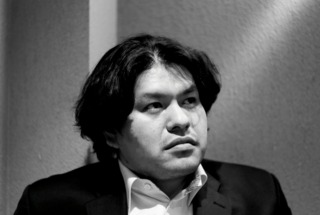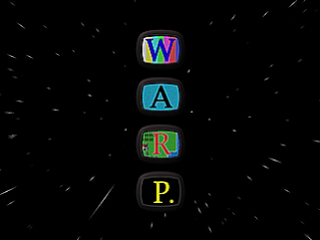Founding
 Kenji EnoKenji Eno
Kenji EnoKenji Eno, the founder of WARP Inc., began his video game career after working for Canon in Japan. Eno had attended a school for gifted children at a young age and later dropped out of high school after the dissapearance of his mother. This deeply affected Eno and he immersed himself in music and video games, becoming fascinated with them both. Disatisfied with his job at Canon, Eno went on to work with video game developers Interlink and
Eim Ltd. At each of these two companies he was given a moderate amount of control and Eno learned how to lead and produce a video game development project.
WARP Inc. was founded in 1994 by Kenji Eno, following his time at Interlink and EIM Ltd. WARP defined itself as a unique and different video game developer. The company's total sales surpassed two million. Eno directed or co-directed the music for several of the games he would produce for WARP, D and D2 and music for other Japanese game developers' games.
History
 WARP, Inc. corporate logo
WARP, Inc. corporate logoWARP was one of the first companies to create and develop games for the
3DO platform. The company would later go on to develop for the Sega consoles the
Saturn and the
Dreamcast. WARP originally created the game
D for the 3DO console and then would later create the games
Real Sound and
Enemy Zero for the Sega Saturn and eventually the game
D2 for the Sega Dreamcast.
 WARP's virtual actress Laura
WARP's virtual actress LauraWARP characterized itself and its games at times as "interactive fiction." This seemed appropriate as the company was an early 3DO and multimedia developer. The company also used FMV thoroughly throughout its games to tell its stories and plotlines. The company used a "virtual actress," basically a character model, named
Laura in several of their games; namely D, Enemy Zero and D2. WARP existed during the height of the so called multimedia boom of the nineties when CD-ROM technology was on the rise.
For most of its duration, WARP consisted of a team of only five developers. Some of whom went on to work and have succes further in their career, including
Fumito Ueda. Ueda would go on to design and develop
ICO and
Shadow of the Colossus.
After the game D2, the company changed its name to Superwarp and abandoned the video game industry. The new company would go on to work on and create DVDs, networking services and online music. Eventually, Superwarp would also go on to be retired in 2005.
Games
WARP created and devloped nine games over its existence. Those nine games were
Totsugeki Kikan (Karakuri) Megadasu!!,
Trip'd,
Oyaji Hunter Mahjong, D,
Short Warp, Real Sound, Enemy Zero, Real Sound: Kaze no Regret and D2. Here are description of select games from WARP's catalog.
Among the first games developed by WARP was D's Dinner Table, or more simply D. Not only was D one of the company's first games, it was also the company's first game to be in the "interactive fiction" syle that the company came to be known for. D was initially developed on only three
Amiga computers. Most parties at the time considered the 3D visuals used in the game a miraculous feat, especially considering the small number of developers and computers used to create the game.
The game was an adventure game in which the main character Laura Harris must find out why her father has gone on a murderous rampage and is holding hostages in a hospital. This was the first game to use the WARP character "Laura." The game used pre-generated computer graphics and full motion video to tell its story. The player had two hours to solve the mystery of why Laura's father went on his bloody maasacre.
The game had several endings, a time's up ending, a. good and bad ending and a 100% completion ending. The ending a player witnessed was based on their actions throughout the game. The 100% complete ending included the good ending and the addition of the sounds of a newborn baby crying. Some players concluded that this sound of the baby crying to mean that the main character gave birth at the end of the game, a storyline development that would lead to D2.
D was originally released on the 3DO console and was later ported to the Playstation, Sega Saturn and PC by Acclaim. The game had a very high sell through rate on all those consoles, but the Playstation. The game was considered a sensational hit in Japan.
It is rumored that the Playstation game received the most pre-orders, but Sony failed to produce enough copies of the game to meet the demand. Eno decided to sever all further ties with Sony for further WARP developed games. Eno said in an interview with 1UP.com in 2008 "So the sales people had gotten 100,000 preorders from retailers, but Sony wasn't able to manufacture all of them. I was very pissed about that, because one title like that for a small company is very important. If that game doesn't sell well, then that's very bad for the company."
WARP and Eno went on to create their next games exclusively for the Sega Saturn video game system as a result of the debacle with Sony. WARP's next game was an unusual one and very different for the market, but not that unusual a choice for the enigmatic Eno. WARP and Eno decided to create a game that solely relied upon sound for the Sega Saturn. There would be no visuals in the game at all. The game was titled Real Sound: The Wind's Regret and was released in 1997. The game was created and developed in response to the number of blind and visually impaired players of previous games from the studio. Kenji Eno himself lead the charge to create the game. He was inspired to develop the game after his own personal communication with the visually impaired fans of WARP games. He was fascinated with the idea that fans who could not see still apprciated his games, especially because he thought his games up to this point were so reliant on visuals with their use of FMV and pre-generated computer graphics.
Enemy Zero or E0 was the studio's next Sega Saturn game. The game used elements from both of the previous studio's efforts, D and Real Sound. Enemy Zero used the Laura character again, but this time the setting was completely different, outer space. E0 also took some influence from Real Sound by incorporating sound and audio as an integral part of and mechanic for the game. Lastly, the game also made use FMV as D did.
In this game, Laura is a character in crogenic sleep on a space craft, the Aki, and has awoken to a catastrophic event on her space ship. She must battle an invading invisible enemy on the ship through the use of sound. A changing pitch tells the player how close the enemy is.
 The Enemy Zero Limited Edition crate
The Enemy Zero Limited Edition crateEnemy Zero had perhaps the most expensive and exclusive limited edition version of a video game ever. The limited edition version of the game had only twenty copies. Twenty crates which contained all of the limited edition materials were produced. The limited edition of the game included a T-Shirt, a VHS tape with music clips from the game, a replica of the game's gun, actual design documents used in the game, a full outfit as worn by companion girls at WARP's 1996 Tokyo Game Show booth and various other paraphenalia. At the time, the limited edition version of Enemy Zero cost 200,000 yen each, that is approximately $2500 US dollars. Kenji Eno personally delivered the crates to each buyer himself on a truck.
D2 was originally designed as a direct followup to D. Not only that, it would also be among the first games developed for the M2, 3DO's video game platform designed to
 Original M2 version of D2 screen shot
Original M2 version of D2 screen shotbe the followup to their first console and to be manufactured by Panasonic. Because the M2 was cancelled by Panasonic/Matsushita and never came to fruition, the original design for D2 was also cancelled. The original M2 design of the game had the Laura character's unborn child stolen from her by a otherworldly power. The child is then miraculously aged and transported back in time to a medeivel castle that the player must escape from. Some game players beleive that this game was more directly related to the first game, it being related to the sounds of the newborn baby that were featured in one of the endings of the first game, D. Unfortunately, the storyline and the affects that it would have on the second game were dropped when D2 was cancelled and redesigned for the Dreamcast.
Development of D2 for the M2 had progressed so far that marketing for the game was planned and flyers were printed up. Rumors abound that the game was nearly complete and could have been released. The rights to the game were held by Panasonic/Matsushit as the publisher ot the game. The enterprise gained the rights to all the planned and developed M2 games upon the purchase of the M2 system from 3DO. The original M2 version of D2 and other M2 games were never released in any form.
D2 did eventually come to light and was redesigned by WARP for the Sega Dreamcast, but the game and its story was completely redesigned. D2 was also the first game to officially be announced for the Sega Dreamcast console. In the game the Laura character is now controlled by the player, as opposed to the original design where the player controlled Laura's child. In the games plot, Laura is on a airflight that is attacked by terrorists, but the terrorists attack is then interrupted by the plane being struck by a meteorite. The plane crashes in a frigid Northern Canadian wasteland. Laura must then find her way out of the snowbound wasteland, but she soon finds it more difficult due to the attacks of stange otherworldly creatures. Eventually through exploration the player finds other survivors of the plane crash, but those survivors are transforming into the selfsame creatures that Laura must contend with. Gameplay was a combination of third person exploration, first person perspective and even some adventure game item collection.
Post WARP, Inc.
 From Yellow To Orange corporate logo
From Yellow To Orange corporate logoThe second incarnation of WARP, Superwarp, would also eventually come to a close.
From Yellow To Orange would be the new company that Kenji Eno would go on to found next from the ashes of Superwarp. Unlike Superwarp which moved away from video game development, From Yellow To Orange would be a video game company again. Kenji Eno is the CEO of the company and the company has released the Wii game
Kimi to Boku to Rittai (You, Me and Shape).
Log in to comment